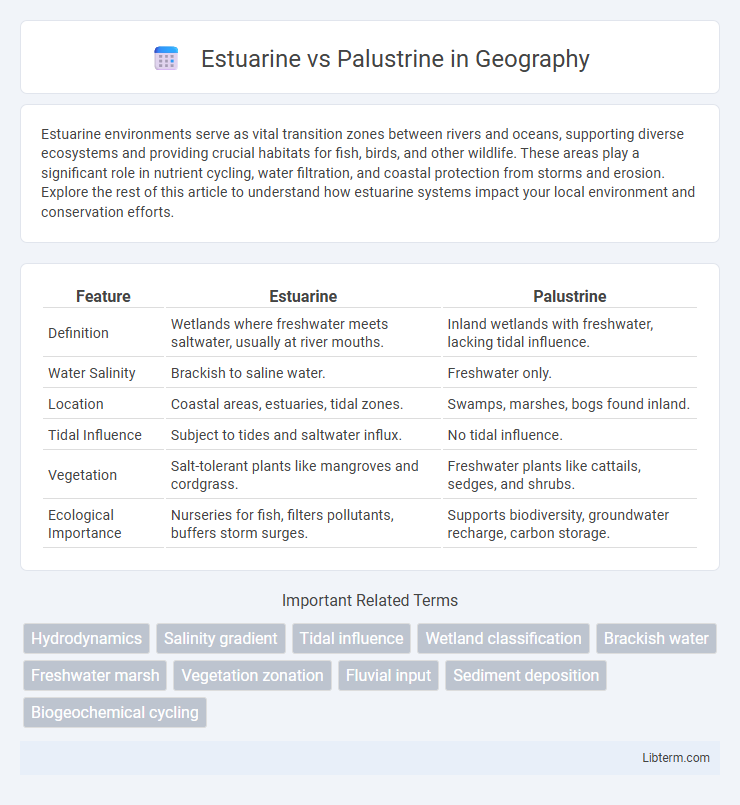Estuarine environments serve as vital transition zones between rivers and oceans, supporting diverse ecosystems and providing crucial habitats for fish, birds, and other wildlife. These areas play a significant role in nutrient cycling, water filtration, and coastal protection from storms and erosion. Explore the rest of this article to understand how estuarine systems impact your local environment and conservation efforts.
Table of Comparison
| Feature | Estuarine | Palustrine |
|---|---|---|
| Definition | Wetlands where freshwater meets saltwater, usually at river mouths. | Inland wetlands with freshwater, lacking tidal influence. |
| Water Salinity | Brackish to saline water. | Freshwater only. |
| Location | Coastal areas, estuaries, tidal zones. | Swamps, marshes, bogs found inland. |
| Tidal Influence | Subject to tides and saltwater influx. | No tidal influence. |
| Vegetation | Salt-tolerant plants like mangroves and cordgrass. | Freshwater plants like cattails, sedges, and shrubs. |
| Ecological Importance | Nurseries for fish, filters pollutants, buffers storm surges. | Supports biodiversity, groundwater recharge, carbon storage. |
Introduction to Estuarine and Palustrine Systems
Estuarine systems are coastal water bodies where freshwater from rivers meets and mixes with saltwater from the ocean, creating unique brackish habitats characterized by tidal influences and variable salinity levels. Palustrine systems encompass inland, non-tidal wetlands such as marshes, swamps, and bogs dominated by persistent emergent vegetation or woody plants, typically lacking significant open water and marine influence. Both systems play critical roles in biodiversity conservation, nutrient cycling, and water filtration within their respective ecological zones.
Defining Estuarine Wetlands
Estuarine wetlands are coastal ecosystems where freshwater from rivers meets and mixes with saltwater from the ocean, characterized by tidal influences and brackish water conditions. These wetlands support diverse habitats such as salt marshes and tidal flats, which serve as crucial nurseries for many marine species and act as natural buffers against storm surges and erosion. Estuarine environments differ from palustrine wetlands, which are inland freshwater systems like swamps and marshes, lacking tidal influence and saline conditions.
Characteristics of Palustrine Wetlands
Palustrine wetlands are characterized by their non-tidal, freshwater environment, typically found in inland areas such as marshes, swamps, and bogs. They support a diverse range of vegetation, primarily woody plants like shrubs and trees, and exhibit saturated soil conditions with slow-moving or stagnant water. These wetlands play a crucial role in water filtration, flood control, and providing critical habitat for a variety of wildlife species.
Key Differences Between Estuarine and Palustrine Wetlands
Estuarine wetlands are coastal areas influenced by tidal saltwater mixing with freshwater, supporting brackish water ecosystems, whereas palustrine wetlands are inland, freshwater systems like marshes, swamps, and bogs with no tidal influence. Estuarine wetlands exhibit fluctuating salinity, high nutrient exchange, and diverse aquatic species adapted to saline conditions, while palustrine wetlands maintain relatively stable freshwater conditions, supporting varied vegetation such as cattails and sedges. Hydrology differs significantly, with estuarine wetlands subject to tidal flows and palustrine wetlands dependent on precipitation, groundwater, and surface water inputs.
Hydrology: Salinity and Water Sources
Estuarine environments feature brackish water influenced by tidal mixing of freshwater from rivers and saline seawater, resulting in variable salinity levels that impact ecological dynamics. Palustrine systems are primarily freshwater wetlands, fed by precipitation, surface runoff, and groundwater, with minimal to no connection to marine waters, maintaining consistently low salinity. The hydrology in estuaries is dynamic, driven by tidal fluxes and river discharge, while palustrine wetlands experience more stable water sources with seasonal fluctuations in water table and saturation.
Vegetation Types in Estuarine vs Palustrine Wetlands
Estuarine wetlands are dominated by salt-tolerant vegetation such as cordgrass (Spartina spp.), eelgrass (Zostera spp.), and mangroves, which thrive in brackish to saline water conditions. Palustrine wetlands primarily feature freshwater vegetation, including cattails (Typha spp.), sedges (Carex spp.), and shrubs like alders (Alnus spp.), adapted to non-tidal, saturated soils. The distinction in vegetation types reflects the varying salinity, hydrology, and substrate characteristics between estuarine and palustrine wetland ecosystems.
Ecological Functions and Biodiversity Comparisons
Estuarine wetlands, characterized by brackish water and tidal influence, support high biodiversity by providing critical nursery habitats for fish, shellfish, and migratory birds, while enhancing nutrient cycling and water filtration. Palustrine wetlands, typically freshwater and non-tidal, excel in flood control, groundwater recharge, and carbon sequestration, fostering diverse plant and amphibian communities adapted to saturated soils. Both wetland types sustain unique ecological functions essential for maintaining regional biodiversity and ecosystem health.
Human Impacts and Threats
Estuarine ecosystems face significant human impacts such as pollution from agricultural runoff, urban development, and industrial discharge that degrade water quality and disrupt critical habitats. Palustrine wetlands experience threats from land conversion for agriculture, drainage for urban expansion, and the introduction of invasive species, leading to loss of biodiversity and altered hydrology. Both ecosystems are vulnerable to climate change effects, including sea level rise and altered precipitation patterns, which exacerbate existing anthropogenic stresses.
Conservation and Management Strategies
Conservation and management strategies for estuarine and palustrine ecosystems must address their unique hydrological and ecological characteristics. Estuarine environments, influenced by tidal exchange and salinity gradients, require strategies that manage nutrient runoff, habitat restoration, and pollution control to maintain water quality and biodiversity. Palustrine systems, typically freshwater wetlands, benefit from hydrological regime preservation, invasive species control, and buffer zone establishment to support carbon sequestration and wildlife habitats.
Conclusion: Importance of Both Wetland Types
Estuarine and palustrine wetlands each play crucial roles in maintaining biodiversity, water quality, and flood control within their ecosystems. Estuarine wetlands act as vital buffers between marine and freshwater environments, supporting diverse aquatic life and nutrient cycling. Palustrine wetlands provide essential habitats for terrestrial and aquatic species while enhancing groundwater recharge and carbon sequestration.
Estuarine Infographic

 libterm.com
libterm.com